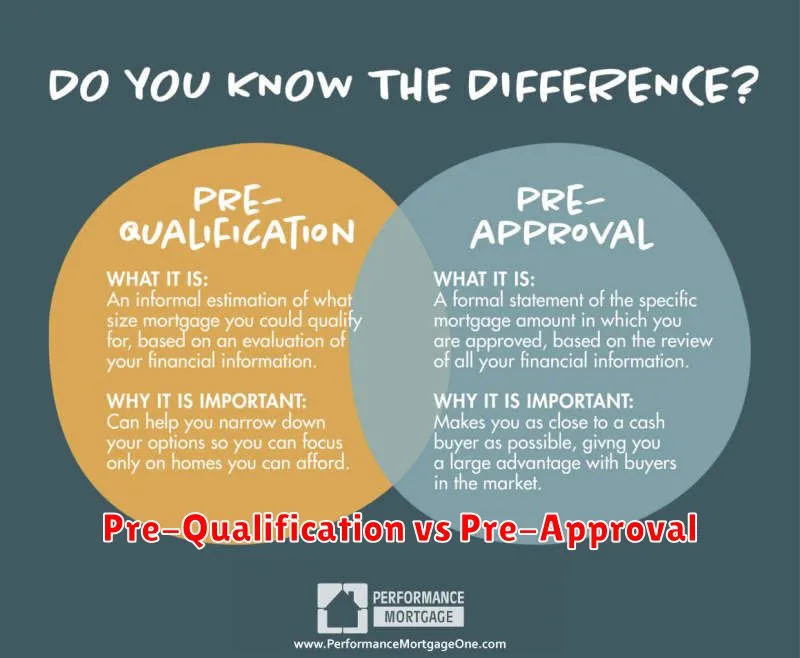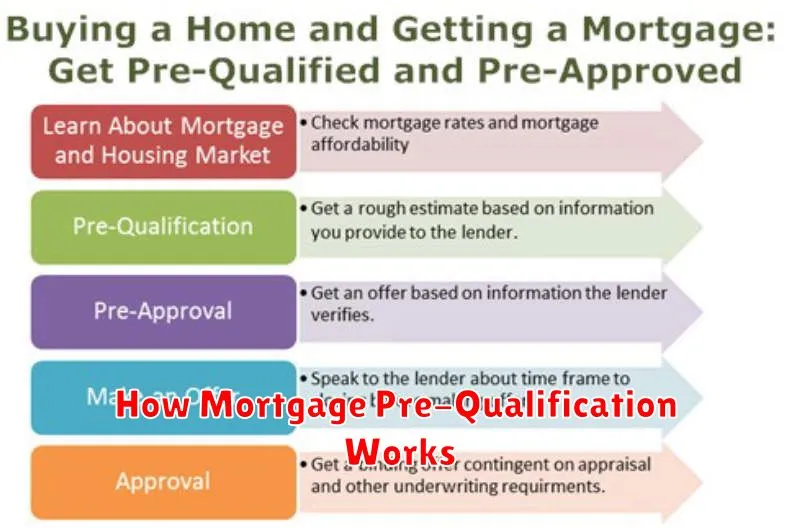Are you dreaming of owning a home? Understanding the mortgage pre-qualification process is a crucial first step in making that dream a reality. This guide will walk you through the intricacies of pre-qualification, explaining how it works and why it’s a vital tool for homebuyers. We’ll cover everything from the required documentation to understanding your credit score’s impact on your pre-approval, helping you navigate the mortgage landscape with confidence. Learn how pre-qualification empowers you to shop for homes within your affordable price range and gives you a significant advantage when making an offer.
Mortgage pre-qualification isn’t just about getting a number; it’s about gaining valuable insight into your financial readiness for homeownership. This process provides a realistic estimate of how much you can borrow, allowing you to focus your home search effectively. We’ll delve into the differences between pre-qualification and pre-approval, clarifying the steps involved in each and highlighting the benefits of pursuing both. By understanding the mortgage pre-qualification process, you’ll be better equipped to negotiate favorable terms, secure your dream home, and confidently navigate the exciting journey of becoming a homeowner.
Pre-Qualification vs Pre-Approval

While both pre-qualification and pre-approval are important steps in the mortgage process, they represent significantly different levels of commitment and scrutiny from a lender. Understanding the distinction is crucial for homebuyers.
A pre-qualification is a relatively informal process. It typically involves providing a lender with some basic financial information, such as your income, debts, and assets. Based on this information, the lender will give you a rough estimate of how much you might be able to borrow. This estimate is not a guarantee of loan approval and lacks the detail of a pre-approval.
In contrast, a pre-approval is a much more thorough and formal process. It requires the submission of extensive documentation, including pay stubs, tax returns, and bank statements. The lender will then verify this information and conduct a credit check. A pre-approval letter, if issued, provides a more accurate indication of your borrowing power and significantly strengthens your offer when making an offer on a home. It demonstrates to sellers that you are a serious buyer with a higher likelihood of securing financing.
The key difference lies in the level of due diligence. Pre-qualification provides a preliminary idea of affordability, while pre-approval involves a comprehensive review of your financial situation. Choosing between the two depends on your individual circumstances and goals. If you’re just starting your home search and want a general sense of your budget, pre-qualification might suffice. However, if you’re ready to make an offer on a property, a pre-approval is strongly recommended.
What Info Lenders Look For
When you pre-qualify for a mortgage, lenders assess your financial health to determine your eligibility for a loan. They’re primarily interested in understanding your creditworthiness and ability to repay the loan.
Credit score is a crucial factor. Lenders will pull your credit report from one or more of the three major credit bureaus (Equifax, Experian, and TransUnion) to see your credit history, including payment patterns, outstanding debts, and bankruptcies. A higher credit score generally translates to better loan terms and a higher chance of approval.
Your debt-to-income ratio (DTI) is another key metric. This ratio compares your total monthly debt payments (including the potential mortgage payment) to your gross monthly income. A lower DTI indicates a greater ability to manage debt and increases your likelihood of approval. Lenders typically prefer a DTI below 43%, but the specific threshold varies depending on the lender and the type of loan.
Lenders also need details about your income and employment history. They’ll want to see proof of consistent income, usually through pay stubs, W-2 forms, or tax returns. The stability of your employment plays a significant role in demonstrating your ability to make consistent mortgage payments.
Assets, such as savings accounts, investments, and retirement funds, are also considered. These demonstrate your financial resources and capacity to handle unexpected expenses or potential financial setbacks. The more substantial your assets, the stronger your application will be.
Finally, lenders will review your employment history and assess the stability of your job. A long and consistent employment history usually boosts your application. However, even with a shorter history, a strong credit score and other financial indicators can still lead to approval.
How Accurate Is Pre-Qualification?
Mortgage pre-qualification provides a rough estimate of how much you might be able to borrow. It’s based on the information you provide, and it’s not a guarantee of loan approval.
The accuracy depends heavily on the completeness and honesty of the information you submit. Minor inaccuracies in your self-reported income or debts might not significantly impact the pre-qualification amount, but major discrepancies can lead to a vastly different result during the formal underwriting process.
Furthermore, pre-qualification typically doesn’t involve a full credit check or a detailed review of your assets. A full credit check, conducted during the pre-approval process, can reveal factors that might affect your eligibility, such as late payments or bankruptcies, that weren’t considered during pre-qualification.
Interest rates are also a significant variable. Pre-qualification often uses current rates as a benchmark, but these can fluctuate before you officially apply for a loan. A change in interest rates can alter your potential borrowing power, as the amount you can afford to borrow is directly affected by your monthly payment.
Therefore, while pre-qualification offers a valuable initial insight into your potential borrowing capacity, it’s crucial to remember that it’s only a first step. The actual loan amount you qualify for may differ significantly after a complete underwriting review and official loan application.
Benefits for First-Time Buyers
Pre-qualification for a mortgage offers several key advantages to first-time homebuyers. It provides a crucial head start in the often-competitive real estate market.
Firstly, pre-qualification gives you a clear understanding of your buying power. Knowing your budget beforehand allows you to focus your home search on properties within your realistic price range, saving time and preventing disappointment by looking at homes outside your financial capabilities.
Secondly, being pre-qualified strengthens your position when making an offer on a home. Sellers are more likely to take your offer seriously knowing you’ve already demonstrated financial readiness. This can be especially beneficial in a seller’s market where multiple offers are common. A pre-qualification letter acts as proof of your financial capability and seriousness.
Furthermore, the pre-qualification process itself can be a valuable learning experience. It familiarizes you with the mortgage process, the various loan options available, and helps you understand the necessary documentation required for a full mortgage application. This knowledge can reduce stress and anxiety later in the home-buying journey.
Finally, pre-qualification doesn’t obligate you to a specific mortgage. It simply gives you a realistic estimate of how much you can borrow, empowering you to make informed decisions throughout the home-buying process. You retain the flexibility to shop around for the best mortgage rates and terms once you’ve found your dream home.
What Happens After You Qualify
Once you’ve successfully pre-qualified for a mortgage, you’ll receive a pre-qualification letter outlining the estimated loan amount you’re eligible for. This letter is a crucial document that demonstrates to sellers that you’re a serious buyer and have the financial capacity to purchase a home within your approved budget. It’s important to remember that this is not a formal loan approval.
The next step involves finding a home you’d like to purchase. Once you have a specific property in mind, the next stage is a formal loan application. This involves providing significantly more detailed financial information to the lender, including tax returns, pay stubs, bank statements, and potentially other documentation depending on your situation. This detailed review process allows the lender to determine your precise eligibility for a mortgage.
During this formal application process, the lender will conduct a thorough review of your credit history and financial stability. They will verify the information you’ve provided and assess your overall risk as a borrower. This process can take several weeks, and it’s important to be responsive to lender requests for additional documents. The quicker you provide the necessary information, the faster the process will be completed.
Following the thorough review of your application, the lender will provide you with a formal loan approval, or a clear explanation of any required steps for improving your eligibility. This formal approval specifies the exact loan terms, including the interest rate, loan amount, and monthly payments. Only after receiving this formal approval can you confidently proceed with the purchase of your home.
What Documents You’ll Likely Need
The documents required for mortgage pre-qualification can vary slightly depending on the lender, but generally, you’ll need to provide several key pieces of information to support your application. Be prepared to provide accurate and up-to-date documentation; inaccuracies can delay or even derail the process.
Identification is crucial. This typically includes a government-issued photo ID, such as a driver’s license or passport. You’ll also need to provide proof of income. This might take the form of pay stubs from your employer, W-2 forms, tax returns, or bank statements showing regular deposits.
Lenders will want to assess your creditworthiness. Therefore, expect to provide information about your credit history, often in the form of a credit report. You may also need to provide details about any existing debts, such as outstanding loans or credit card balances. This helps the lender understand your overall financial picture.
Finally, you will likely need to provide information related to the property you intend to purchase. While you won’t need a purchase agreement at this stage, you may need to provide details such as the address of the property and an estimate of its value.
Gathering these documents beforehand can streamline the pre-qualification process and help you receive a quicker response from your lender. It is advisable to organize your financial documents in advance to ensure a smooth and efficient application.

